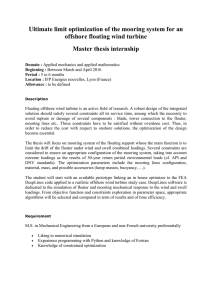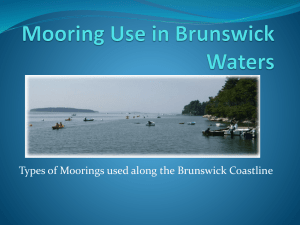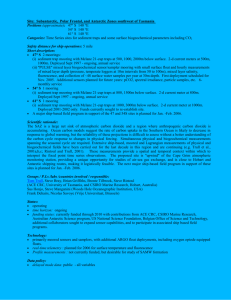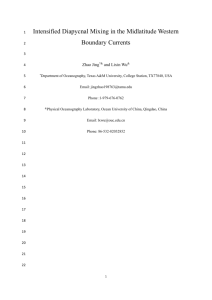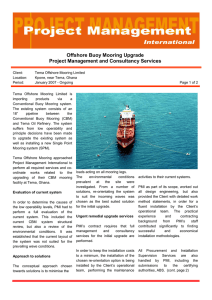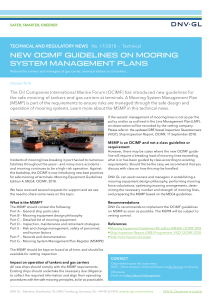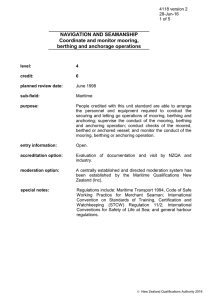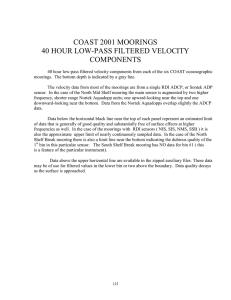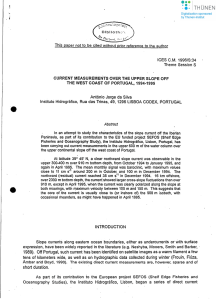Lesson Plan
advertisement
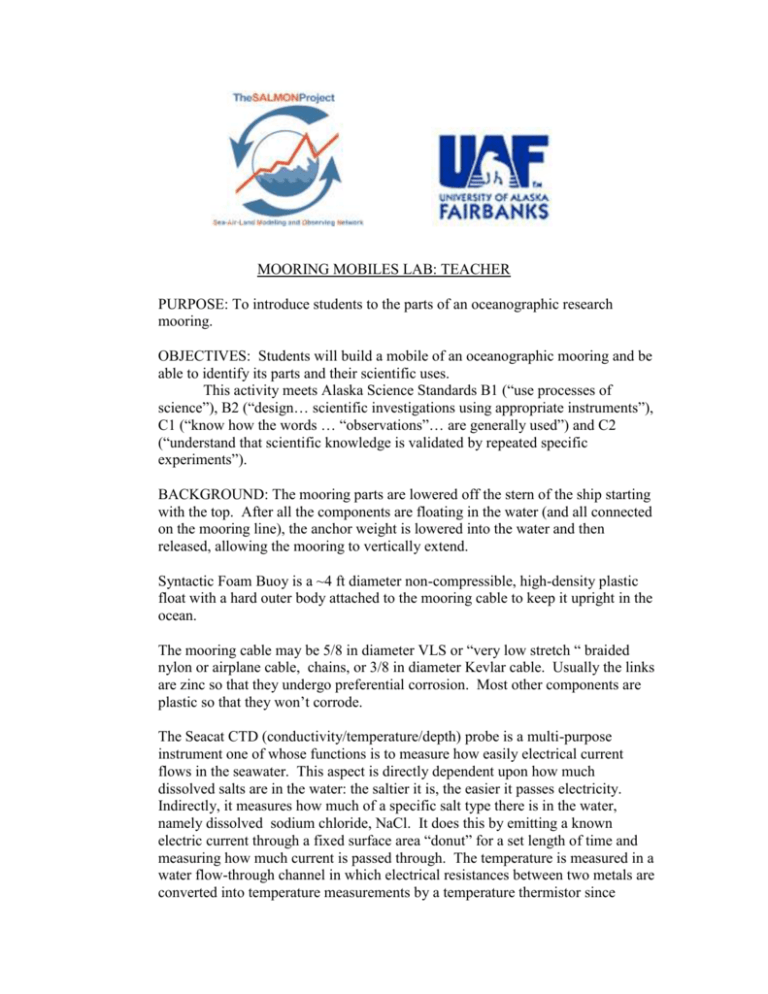
MOORING MOBILES LAB: TEACHER PURPOSE: To introduce students to the parts of an oceanographic research mooring. OBJECTIVES: Students will build a mobile of an oceanographic mooring and be able to identify its parts and their scientific uses. This activity meets Alaska Science Standards B1 (“use processes of science”), B2 (“design… scientific investigations using appropriate instruments”), C1 (“know how the words … “observations”… are generally used”) and C2 (“understand that scientific knowledge is validated by repeated specific experiments”). BACKGROUND: The mooring parts are lowered off the stern of the ship starting with the top. After all the components are floating in the water (and all connected on the mooring line), the anchor weight is lowered into the water and then released, allowing the mooring to vertically extend. Syntactic Foam Buoy is a ~4 ft diameter non-compressible, high-density plastic float with a hard outer body attached to the mooring cable to keep it upright in the ocean. The mooring cable may be 5/8 in diameter VLS or “very low stretch “ braided nylon or airplane cable, chains, or 3/8 in diameter Kevlar cable. Usually the links are zinc so that they undergo preferential corrosion. Most other components are plastic so that they won’t corrode. The Seacat CTD (conductivity/temperature/depth) probe is a multi-purpose instrument one of whose functions is to measure how easily electrical current flows in the seawater. This aspect is directly dependent upon how much dissolved salts are in the water: the saltier it is, the easier it passes electricity. Indirectly, it measures how much of a specific salt type there is in the water, namely dissolved sodium chloride, NaCl. It does this by emitting a known electric current through a fixed surface area “donut” for a set length of time and measuring how much current is passed through. The temperature is measured in a water flow-through channel in which electrical resistances between two metals are converted into temperature measurements by a temperature thermistor since resistance (the inverse of conductivity) varies with temperature. Finally, the depth is measured with a pressure cell. The more pressure, the greater the depth; it is calibrated for seawater. These CTDs are placed at different depths to measure and record how these different factors vary with depth of water. The nitrate sensor measures concentrations of nitrogen and oxygen bonded together (NO3) in the water. It does so by collecting a little of the seawater in a box. The seawater is then mixed with another chemical and a colorimeter measures the color change. The color change tells how much nitrate there is. Nitrate concentrations are generally low in the offshore regions of Gulf of Alaska and are higher in coastal waters. Nitrate is a requirement for plant (phytoplankton) growth. The vinyl floats are smaller diameter buoys helping to stabilize and keep the mooring cable upright. The Microcat CTD is another type of conductivity-temperature-depth sensor. It has a vane or arm attached to it so that it keeps the instrument oriented in the direction that the water is flowing The sediment trap is a device that captures particles of debris falling down through the seawater. It opens from time to time to catch them. They may be inorganic particles of minerals from river runoff or stirred up from the seafloor, or they may be organic debris, all the parts and bodies of plants and animals. The acoustic release is a mechanical coupling device that holds the mooring cable to the anchor, but then releases it when it receives a special sound signal from the research vessel. When released from the anchor, the mooring floats to the surface. Once sighted, the mooring is slowly approached by the research vessel and then the top mooring part is snagged with a gaff hook. Its line is attached to the winch hook and dragged in, beginning the retrieval process for all of the mooring. The train wheel anchors are just that- heavy, strong, available pieces of metal suitable for anchoring the entire system. The above sensors were on a bio-physical mooring. Other moorings measure just physical characteristics, such as temperature, conductivity, depth and currents. These are physical moorings. The RDI or Research Design Instruments ADCP is an acoustic Doppler current profiler. It is a device that measures the speed and direction of currents at many different depths above it. It does so by sending out a vibrational (sound or acoustic) wave that is reflected off of particles that are about the size of your pinky finger and smaller in the water. The wave shifts its frequency (how many wave crests pass a location in a second, or how many “jiggles” it has in a certain time) according to whether it is going with the direction of flow of the water or against it. This shift is the Doppler Effect and it explains the phenomenon of a siren gaining a higher pitch or tone as the fire engine speeds towards you, or lowering tone as it speeds away from you. Some other sensors not shown are: PAR- standing for Photosynthetically-Active Radiation, measuring how much sunlight is available for plants to grow at depth. A fluorometer estimates how much chlorophyll there is in the water. Remember chlorophyll is the green pigment which captures the sun’s energy and converts it into plant energy through photosynthesis. When chorophyll is hit with certain light, it absorbs it and gives back off light of a different type. This new type of light is fluorescence. Thus, the amount of fluorescence is also a measure of how much chlorophyll there is in the water. A transmissometer measures how much light from a beam passes through a given volume of water. Light can be lost by absorption or scattering by the particles in the water. The transmissometer is corrected for absorption and measures scattering primarily. In effect it is like an electronic Secchi disk. And a ULS for “upward-looking sonar”, is another type of underwater radar that can measure ice thickness. MATERIALS: Sewing needles, dental floss, tooth picks, ring stands and bases, Chex, big orange, yellow, red, or green gumballs (DOTS), Gummi bears and worms, spice drops, black licorice twists, and chocolate mini-donuts (or any other soft candy that can be speared and held together). PROCEDURE: Discuss the SALMON Project’s physical and bio-physical oceanographic moorings: design, parts, uses, deployment, retrieval (see above notes). Show the graphics (make overheads) of the moorings. Discuss what each sensor measures. Then show the model setup (if you have one), explaining how to use dental floss and needle to thread through the different foodstuffs to make an edible model of an oceanographic mooring. Use toothpicks for a vane to a Microcat CTD. See if they can figure out the appropriate uses for the donut! Creativity with accuracy is encouraged. Have a second adult at another distribution center. Both of you quiz the students to check their “parts” (candy) request before you dole out the goodies, needle and floss. Lastly, after they have been working with parts flat on their desk, then they can hang them up (off ring stands if available) or have them come to you for their identification. CONCLUSION: Students identify two different sensors on their mooring, naming them and what they do (how they operate is even better). If they are correct, they may consume these sensors! Have students take them home to show and explain to their families. NOTE: CUT NEEDLES OFF DENTAL FLOSS AND DISPOSE PROPERLY! SOURCES: See our website about a real mooring in the northern Gulf of Alaska, http://halibut.ims.uaf.edu:8000/SALMON/GAK4/gak4.html

